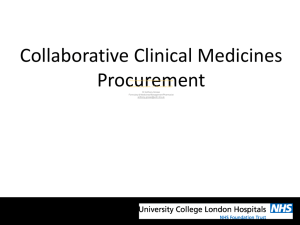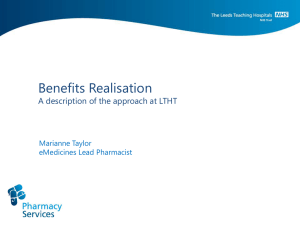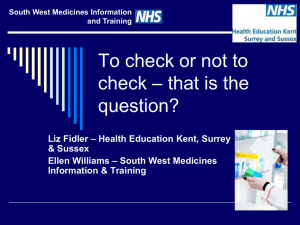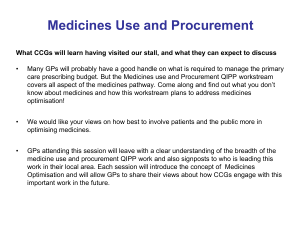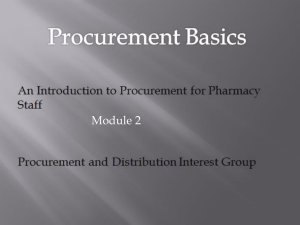Beth Loudon
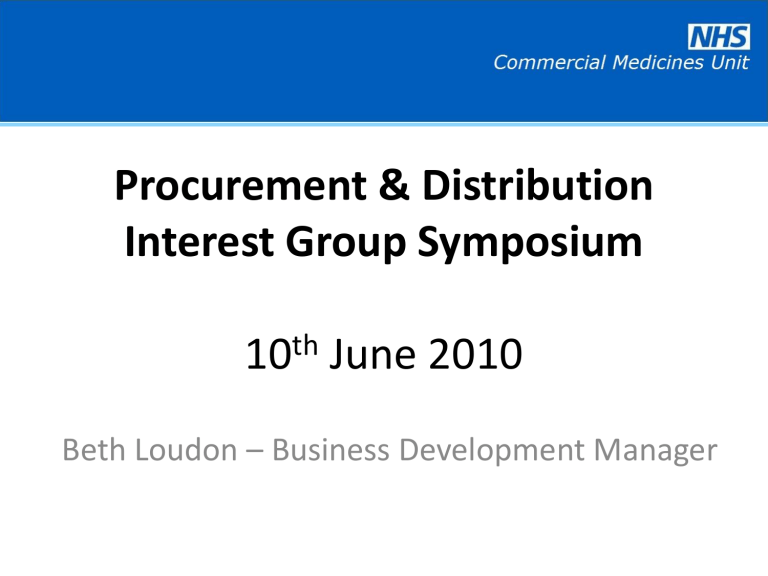
Procurement & Distribution
Interest Group Symposium
10 th June 2010
Beth Loudon – Business Development Manager
What is the NHS Commercial Medicines Unit?
What is our role and governance?
What is a Commercial Support Unit (CSU) and what is its potential role in medicines management?
How is the procurement landscape developing for medicines management?
NHS CMU – Who?
A team within PICD (Procurement, Investment and Commercial
Division) at Department of Health from 1 st January 2010.
Previously Pharmacy Directorate of NHS Purchasing and Supply
Agency, roles and responsibilities remain unchanged.
Teams in Reading and Runcorn and 11 Homeworkers
Core purpose is to: deliver efficiencies for the NHS and DH in the procurement of medicines support purchasing for safety of those medicines ensure an efficient and effective supply chain of medicines to the patient.
NHS CMU Governance
Department of
Health –
Procurement,
Investment and
Commercial
Division
(Peter Coates)
NHS COMMERCIAL MEDICINES UNIT
Chris Theaker – General Manager
Teams based in Runcorn and Reading
Efficiency
We deliver efficiencies through: the delivery of national and regional contracts for medicines for secondary care in the NHS the delivery of best value on all DH central procurement of medicines, including vaccines and flu pandemic products the use of our unique national spend and usage data collection system, to provide information and analysis to identify efficiency opportunities available to the NHS and DH, and to support them in measuring and reporting on those efficiencies the offer of supply chain efficiency opportunities to the NHS e.g. improvements in purchase-to-pay systems
Safety
We support purchasing for safety of those medicines through: a bespoke quality control system (PharmaQC) which provides a route from supplier to pharmacist for product safety and quality information working closely with the national QC group to ensure all contracted products have been QC approved ensuring safety considerations are a core criteria in the design and award of our contracts close relationships with the National Patient Safety Agency to ensure that we are supporting the DH in the implementation of policy the use of our professional networks and communication routes to ensure that secondary care pharmacists are instantly aware of any safety alerts
Supply chain
We ensure an efficient and effective supply chain of medicines to the patient through: arranging the storage and distribution for centrally procured medicines analysing the national usage data to forecast and plan for shortages in partnership with the Medicines and Pharmaceuticals Industry
Group (MPIG) the use of our relationships with industry to influence the supply chain of medicines and their raw materials, to ensure that we can scenario plan for shortages and put contingencies in place
What are Commercial
Support Units (CSU)?
Set up in each region and began operating from April 2010
Aim is to build commercial skills within the
NHS by improving commercial acumen and enabling the NHS to drive up quality and facilitate efficient use of resources
They will work with established local structures to determine the best collaborative approach to meet the commercial requirement.
What will a CSU do?
Key functions for
Commissioners might include
• Developing effective patient and public engagement to inform decisionmaking
• Using information effectively to make investment decisions
• Using innovation to improve quality and reduce cost
• Managing and developing suppliers effectively
• Actively managing contractual performance
• Undertaking service review
• Procuring services and using contractual levers to drive productivity
Key functions for Providers might include
• Developing a thorough understanding of NHS markets
• Using patient and public involvement to inform developments
• Identifying business opportunities
• Understanding effectiveness and cost structures of existing organisational arrangements
• Having clear and consistent systems that measure quality and value for money of all services
• Securing business and income
• Using innovation to improve quality and reduce cost
The CSU National
Pharmacy Workstream
To address the following key questions:
-What are the gaps in the provision of support for achieving optimal commercial effectiveness in the use of pharmaceuticals?
-How could a CSU deliver services to fill these gaps?
Work has been undertaken in 4 regions (London, South Central,
West Midlands and North West) to support SHA and CSU leads in developing greater insight and guidance on the role of
CSUs in enabling commercially effective use of pharmaceuticals.
Key stakeholders were identified in each region and 1-2-1 interviews were carried out with a workshop to follow up.
Output is in final draft under consultation
Emerging themes….
Draft Medicines
Management Functions….
Functions Associated services
Core Business Intelligence and
Modelling
Facilitation of
Collaborative Working
Prescribing and spend analysis (including opportunity identification)
Benchmarking
Scenario modelling
Opportunity identification
Project management support for collaboration
Implementation support for national strategies
Adoption of Best Practice and Innovation
Baseline analysis
Resource modelling
Audit support
Identification of best / innovative practice
Benefits tracking for best / innovative practice
Facilitation of sharing materials associated with best practice
Non-
Core
Operational performance Clinical productivity and efficiency assessments
Medicines management capability assessments
Systems
Market Management
E-enablement opportunity identification
E-enablement implementation support
Contract management support
Homecare provider management
How is the procurement landscape changing?
Increased emphasis on commercial rather than procurement tasks and activities
Skills required beyond traditional procurement
Increasing efficiency targets leading to…
Increased pressure on the procurement function
More appetite for radical solutions
